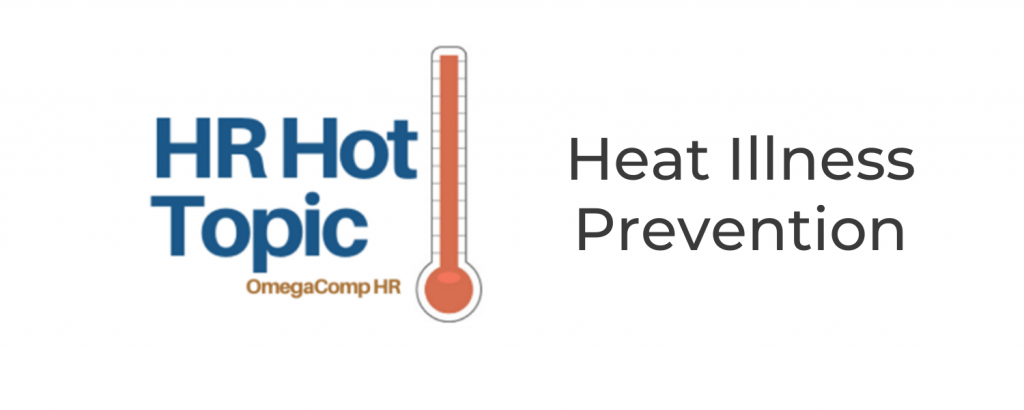HR Hot Topic – Heat Illness Prevention
- Admin

Heat illness is a silent hazard. Heat illness victims may not realize they’re in trouble until the symptoms are advanced. If left unattended, heat illness could lead to heat stroke, a condition that is life-threatening. Employers should be familiar with Cal/OSHA’s heat illness prevention regulation to prevent possible heat-related illness or death. The main points of the regulation include provision of water, access to shade, written procedures, and training.
Drink water – For an eight hour work shift, employers are required to make available two gallons of water per employee. Not all of the water needs to be available at once, but the water supply should allow at least one quart per employee at all times. Workers should consume about three to four cups of water every hour (about one cup every 20 minutes) starting at the beginning of the work shift and throughout the day. Alcohol, coffee, tea, and caffeinated soft drinks, which cause dehydration, should be avoided.
Access to shade – Employers are required to provide workers with a shaded rest area that has good air movement. The area can include buildings, canopies, lean-tos, or even shade trees. A car or other vehicle interiors can be used if shaded, air conditioned, or kept cool in some other way. However, the rest area must not be hazardous (e.g. not underneath tractors or in confined spaces). Employers must allow workers to take periodic rest breaks (when they request it) in these designated shade areas. A rest break in the shade for at least five minutes can reduce potential heat illness.
Written Procedures – The employer’s procedures shall be in writing and shall be made available to employees and Cal/OSHA upon request. The procedures should include complying with requirements of the standard, responding to symptoms of possible heat illness, and contacting emergency services to ensure transportation and precise directions for emergency responders. The written procedures should also ensure that all employees are trained prior to working outdoors and that working hours should be modified to cooler hours of the day whenever possible. When modified hours are not possible, more water and rest breaks will be provided. Supervisors should continuously evaluate environmental factors at the work site (temperature, humidity, radiant heat, and air velocity) to determine if there’s a risk for heat illnesses.
Training—Workers should be trained in heat illness risk factors, how to recognize the early warning signs of heat illness in themselves and in fellow workers, and in first aid measures. The level of heat illness can be affected by a worker’s age, weight, fitness, medical condition, and acclimatization to the heat. Training should include how to prevent heat illnesses, the importance of drinking water, how to slowly build up heat tolerance, and what emergency medical services to call to prevent a delay in life-saving services. When workers cannot communicate directly with emergency services, the employer must identify someone who can.
Most heat-related health problems can be prevented, or the risk of developing them reduced, if a few basic precautions are taken. Encourage workers to:
- Eat wisely. Hot, heavy meals add heat to the body and divert blood to the digestive system, so eat lightly.
- Dress appropriately. Wear lightweight, light-colored, loose fitting clothing, plus a hat. When required, construction workers should wear hard hats to protect against falling objects and shield against the sun’s rays.
- Use, and reapply, sunscreen.
- Keep out of the sun whenever possible.
Work in hot environments will be safer and more productive if every worker on-site is trained to recognize the signs and symptoms of heat illness and knows how to prevent, control, and respond to its effects.
Beat the Heat!
For questions regarding heat illness prevention guidelines
and/or assistance with creating a Heat Illness Prevention Program as required
by Cal/OSHA, please contact our office at 916-266-4370 or info@omegacomp.com.
Source: © State Compensation Insurance Fund Safety Sheet
